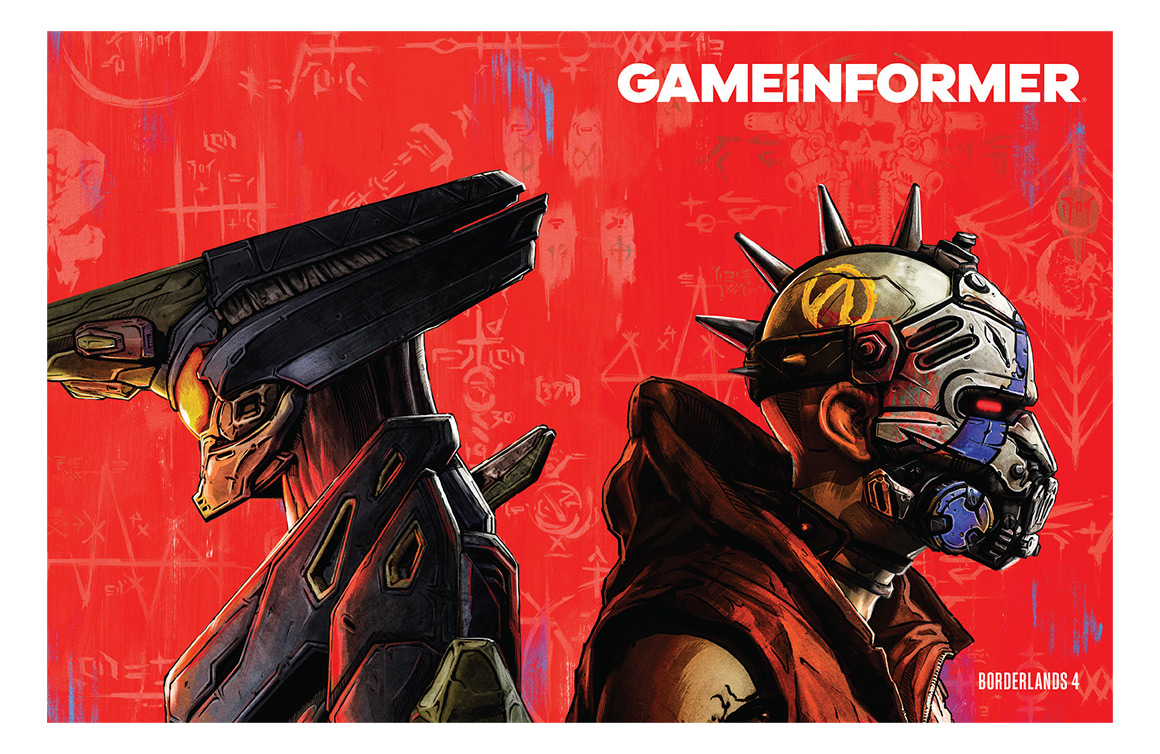Game Informer originally published from 1991 to 2024. Gunzilla Games announced in March that it had acquired the publication. What does this new chapter mean for Game Informer?
From a reader’s perspective, it is a continuation of everything that we were doing during the most recent era of Game Informer.
We’re in a very different era than we were in the 1999. Game Informer started as a brochure back in the early ’90s, then matured into a full-on gaming publication over the next several years. Around 2007-2008, the magazine started doing deep-dive cover stories that we’ve now become known for. We continued to expand on what we could do as a magazine until 2024.
In 2025, Game Informer is back and under Gunzilla Games. We want to continue doing all the stuff that we loved doing before, and all the stuff that our readers loved, but we want to do it bigger and better than before. We have taken the opportunity to rethink our approach to certain things while continuing to do the things that resonate with our readers.
We didn’t want to reinvent the wheel, but this is a new era and an excuse to say “yes” to trying new things while also carrying forward the legacy of the 33 years.

What role does Game Informer play in the gaming industry?
We want to enhance people’s favourite hobby.
Even though gaming is my career, it’s still my favourite hobby. I’ve been at Game Informer for over 10 years now, if you don’t count the weird several months where we were shut down. It’s been my full-time career for over a decade. Before that, I was writing for other publications. I never lost the passion for gaming as a hobby, and as such, I think it is important that we use the platform to enhance folks’ enjoyment of the hobby that we share with them, whether that’s a deep dive into how a game was made with the person who made it, or a critical analysis of a game. There are plenty of ways that we can do that, even if it’s something like a top-10 of games in a certain genre — peripheral entertainment to the main event, which is the games themselves.
We really want to use our magazine and the privilege of an established brand to enhance people’s enjoyment of the games they already love, but also turn them on to games that they may not have heard of. So in addition to covering the games that everybody knows such as Mario Kart World or Elden Ring, we also want to keep our eyes open for up-and-coming games from developers and smaller studios that people may not have heard about.

How do you navigate the relationship between covering games and the often passionate, sometimes critical, gaming community?
I do think that at its core, criticism in gaming comes from a place of passion and excitement for the medium. There are times when it can cross over into a kind of toxic or dark element. Unfortunately, it’s a fact of life and you just have to develop a thick skin. That’s probably true for most people who cover any entertainment medium with fandoms — they can be a vocal minority in a lot of cases.
Ultimately, we have created a pretty awesome community and a very supportive one.

What opportunities do you see for gaming journalism to evolve and grow in the coming years?
That’s a challenging question because, like everything, it feels so up in the air right now.
The rise of influencer culture has drastically changed how many people approach covering video games. For us, we’re trying to find a sweet that is sustainable because that has been a struggle for a lot of outlets over the past decade. We’ve seen major outlets either close completely or fundamentally change — Game Informer included.
Many outlets are realizing that the path that was viable 10 or 15 years ago isn’t nearly as viable now. We’ve recently seen Giant Bomb have a difficult time. Thankfully, the people who were running it were able to acquire the rights to the site from the parent company. Polygon, another well-respected gaming outlet, was sold to a parent company that is shown to have a problematic approach to journalism. They didn’t lay off the entire staff, but they did let go of a good chunk of long-tenured staff. If the parent company’s history with freelance wages is any indication, it might be a dire future for an outlet that I love a lot.
These corporations that start or purchase gaming outlets need to be in it for more than just the monetary value. There needs to be some acknowledgement of the intrinsic value of games media, games journalism, or games criticism. For a lot of these corporations, that’s just not there, and that was something that I was attracted to with Gunzilla Games. When I had my first meeting with them — I’m not the one who spearheaded the deal that ended up happening that resulted in them being able to purchase the brand — they described it as a long-term investment. That’s heartening because you don’t want them to buy the brand and then, after six months, close it because they haven’t turned a profit yet. That does not seem to be at all the case. They seem to be in it for the long haul.
They also seem very interested in getting into the games media space because they do understand the value of having quality games coverage. It just so happened that around the time they were wanting to get into the games media space, Game Informer had closed. Then it became a lot more feasible for them to acquire a major brand.
That kind of thing is essential — there needs to be people who are able to support these outlets financially. Obviously, every business wants to turn a profit, but that’s not the sole reason for being involved in it. It’s like the restaurant industry, where a lot of owners don’t make money for the first two or three years. You have to wait it out and be in it for the love of it first and foremost, then the money will come.
There’s some short-sightedness in the games industry where game development studios are laying off people left and right because the stock goes down or whatever. They’re losing institutional experience and knowledge when they do that. In contrast, look at companies over in Japan — it’s not uncommon for people to work at Nintendo or Square Enix or Capcom for 30 or 40 years. So many times I’ve interviewed people who refer to themselves as “one of the newer guys”, having been there for 2 years. It’s the opposite of how we operate in the West, at least in the game development studios. That translates over to games media as well, because that was one of the major leg-ups that Game Informer had before 2019 — we had so many people with a decade-plus of experience. Then we were hit by a series of layoffs, which also encourages people to leave. That’s really unfortunate.
On that one day in August 2019 when we lost 40% of our editorial staff, we lost something like 107 years of knowledge and experience combined. There’s such instability in games media that it leads people to seek alternative employment. I know people who have been laid off two, three, or four times from games media. When that keeps happening to you, at a certain point, you may move to a different career path.
Having companies that actually believe in games media at its core is a huge opportunity for growth. There will be some balancing of that with profitability, but I think that there needs to be a better balance versus what we’ve seen in the past.
There’s room for expansion into other areas. We’re particularly enthusiastic about expanding our video footprint, something that other outlets, to their credit — places like IGN — do an incredible job with. Danny O’Dwyer of Noclip does a fantastic job with video game documentaries. There’s plenty of space for different, unique approaches. At Game Informer, even though we have had just a one-person video team for a couple of years now, we’ve done documentaries on Humanity, as an example, which is a puzzle game from a few years back that had a lot of critical attention. There’s plenty of room for growth in this area. We’re going to explore that more as we continue to reestablish our brand.
Being a freelancer is perilous, especially right now.
I’m grateful that I have a full-time salary job, but I started as a freelancer in 2008, writing for smaller sites and then co-founded a site that I ran for four years before Game Informer. On the side of all that, I was also doing freelance work for places like IGN, Kotaku, Official Xbox Magazine, and Joystick. Even back then, it was difficult to land a pitch, do the work, go through the edits, and get paid. At some places, you have to go harass the accounts payable department.
Freelance budgets across the industry have dried up in substantial ways. That’s a really difficult thing, and I sympathize. Thankfully, we’re starting to get our freelance budget back up and running. So it is something that we’re again hoping use our position to improve the gaming space more.
To piggyback off of my answer from the previous question, another area that people have really been missing in the gaming space — this is going to sound self-serving, given my position at Game Informer — is print magazines. It’s such a novel thing in this day and age, which is so wild because it’s as old school as it gets.
People are looking for a way to consume this type of coverage without looking at the glowing rectangle that oftentimes gives you anxiety. There’s something different in 2025 about having a tactile print magazine that you can hold in your hand and flip through.
GamePro, Nintendo Power, and EGM — these magazines that we grew up reading have sadly gone away. Even Game Informer went away for about a year; I’m so happy that we’re able to bring it back. I’m seeing a lot of enthusiasm for our subscription program. The only mainstream gaming magazines that I can think of that still exist are Edge in Europe and PC Gamer here in the US. There are obviously fantastic Patreon and Kickstarter-supported outlets as well. I’m a big fan of Nintendo Force Magazine, which is Patreon-supported. But those are the only options. If you’re of a certain age, like me, print magazines hold a special place in your heart.

How can people support Game Informer?
Visit gameinformer.com and create a free account. It gets you access to our digital archive and lets you leave comments on the articles.
You can also create a premium digital subscription for access to exclusive coverage on our website and our most recent issues, which will be put up in their entirety.
The best way to support us is by subscribing to our print magazine. The first issue is out and features Borderlands 4 on the cover — a very big AAA game that we’re excited to dive into. Print subscriptions right now also get you access to our early bird pricing, which is a pretty substantial discount off of what will be our regular price.
The print magazine is only available in the US for the time being. We’re hoping that the relaunch will go smoothly and then we can explore additional territories, at least that’s my personal hope.
Something that I haven’t mentioned yet is that we’ve partnered with St. Jude’s Children’s Research Hospital. Five percent of our proceeds are going to St Jude’s Children’s Research Hospital. It’s an extension of the philosophy about wanting to make the hobby of gaming a better place through our coverage. We also want to make the world a better place at large.
You can find Game Informer on Facebook, Instagram, X, Bluesky and YouTube. We also have the Game Informer Show Podcast. It was one of the longest-running gaming podcasts in the world. As you know, we had a hiatus, but we’re back at it now.

Visit the Game Informer website.



